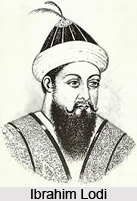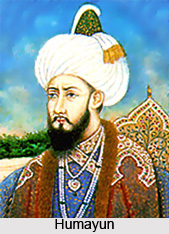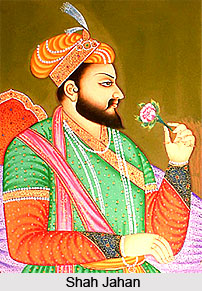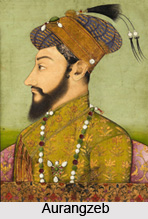 Mughal rule in Lucknow was established after Babur vanquished Ibrahim Lodi in the First Battle of Panipat in 1526 and became the Mughal emperor of Northern India. His son Humayun occupied Lucknow and Ayodhya the same year. Lucknow was lost to the Afghans for a short while, when Humayun went to fight the army of Maharana Sangram Singh (Rana Sanga), the illustrious Rajput chief. Babur reoccupied Lucknow in March 1528 and visited the town on 21 March 1529. This fact indicates the political and strategic importance of the region.
Mughal rule in Lucknow was established after Babur vanquished Ibrahim Lodi in the First Battle of Panipat in 1526 and became the Mughal emperor of Northern India. His son Humayun occupied Lucknow and Ayodhya the same year. Lucknow was lost to the Afghans for a short while, when Humayun went to fight the army of Maharana Sangram Singh (Rana Sanga), the illustrious Rajput chief. Babur reoccupied Lucknow in March 1528 and visited the town on 21 March 1529. This fact indicates the political and strategic importance of the region.
Lucknow continued to enjoy its affluence under the Mughals as is evident in a tradition maintained by the Shaikhs of the town. After his defeat at the hands of Sher Shah at the Battle of Chausa in 1539, Humayun visited Lucknow for a few hours, and the Shaikhs presented him ten thousand rupees and fifty horses. After his historic victory, Sher Shah appointed Isa Khan with a force of five thousand horsemen to restore peace and order in the territories lying between Delhi and Lucknow. He also assigned Lucknow to a nobleman, Qadir Shah, who later became very powerful. Sher Shah raised the status of the city by establishing silver and copper mints at Lucknow for the first time. After Humayun`s re-occupation of Delhi in 1556, Lucknow became a permanent part of the Mughal Empire in spite of frequent risings, for a decade or so, by the unruly Afghan chiefs in the area.
Emperor Akbar consolidated the Mughal Empire and introduced several administrative and fiscal reforms of far-reaching consequences. Lucknow rose to eminence because the Emperor had a great liking for the place. It became the headquarters of a Sarkar of the Suba of Awadh. The copper mint was maintained and Akbar is said to have built several Mohallas to the south of the Chowk. Shahganj is still the most populous locality of Lucknow where the ruins of the historic gateway popularly known as Akbari Darwaza, may be seen.
 During the peaceful reign of Akbar, Brahmins still formed one of the principal sections of the population and the emperor was so well disposed towards them that he favoured them with a lakh of rupees. Since then, the Bajpai Brahmins of Lucknow have been both famous and influential, though the Mohalla to which they gave their name was demolished by the British. Lucknow attained great importance during the reign of Emperor Akbar. The district of Lucknow formed part of the Sarkar of that name in the Suba of Awadh. The names and areas of the Mahals of the Lucknow Sarkar correspond closely with the Parganas of the present day.
During the peaceful reign of Akbar, Brahmins still formed one of the principal sections of the population and the emperor was so well disposed towards them that he favoured them with a lakh of rupees. Since then, the Bajpai Brahmins of Lucknow have been both famous and influential, though the Mohalla to which they gave their name was demolished by the British. Lucknow attained great importance during the reign of Emperor Akbar. The district of Lucknow formed part of the Sarkar of that name in the Suba of Awadh. The names and areas of the Mahals of the Lucknow Sarkar correspond closely with the Parganas of the present day.
The development of Lucknow continued unhampered during the time of Emperor Jahangir. It was then famous for the manufacture of bows. Jahangir had visited Lucknow during the reign of his father and is believed to have founded Mirza Mandi, part of which lay to the west of the site of Machhi Bhavan.
The European traveller De-Laet testifies to the fact that Lucknow was a thriving centre of trade, a Magnum Emporium in the reign of Jahangir. It lay en route from Agra to Jaunpur.
Lucknow continued to thrive under the reign of Emperor Shah Jahan. The old copper mint continued to function during the reign of Shah Jahan.
Emperor Aurangzeb is reported to have visited Lucknow on his return from Ayodhya, and ordered the construction of the impressive mosque on Lakshaman Tila. Shaikh Pir Muhammad, a contemporary scholar and saint, who had migrated from Jaunpur, also lies buried in a square tomb to the north-east of the mosque. His learning and piety attracted large numbers of students and scholars from different parts of the country and his manuscripts are preserved in the Rampur Raza library. The school founded by him remained an important centre of learning for about a century after his death.
Until 1719, subah of Awadh was a province of the Mughal Empire that was administered by a Governor selected by the Emperor.
Mughal Governors of Lucknow
 The earliest known Mughal governor of Lucknow, appointed during the reign of Akbar, was Husain Khan Tukriya. He was transferred from there in 1568, and was succeeded by Mahdi Qasim Khan, a Mansabdar of four thousand, to whom Akbar gave Lucknow. But shortly afterwards in 1572, Lucknow was bestowed on Sikandar Khan, a retired governor of Awadh, who died in the following year. It was then given to Khwaja Amiruddin Mahmud Khwaja Jahan, who was Wazir-i-Mustaqil (permanent minister) of Hindustan. He passed away in Lucknow in 1574. During the closing year of Akbar`s reign Jawahar Khan was Subedar of Awadh. His Naib (deputy), Qasim Mahmud of Bilgram, founded Mahmud Nagar and Shahganj and built the Akbari Darwaza.
The earliest known Mughal governor of Lucknow, appointed during the reign of Akbar, was Husain Khan Tukriya. He was transferred from there in 1568, and was succeeded by Mahdi Qasim Khan, a Mansabdar of four thousand, to whom Akbar gave Lucknow. But shortly afterwards in 1572, Lucknow was bestowed on Sikandar Khan, a retired governor of Awadh, who died in the following year. It was then given to Khwaja Amiruddin Mahmud Khwaja Jahan, who was Wazir-i-Mustaqil (permanent minister) of Hindustan. He passed away in Lucknow in 1574. During the closing year of Akbar`s reign Jawahar Khan was Subedar of Awadh. His Naib (deputy), Qasim Mahmud of Bilgram, founded Mahmud Nagar and Shahganj and built the Akbari Darwaza.
Emperor Shah Jahan is reported to have appointed Sultan Ali Shah Quli Khan as governor of Awadh. Quli Khan`s sons, Mirza Fazil and Mansur, founded Fazil Nagar and Mansur Nagar to the south-west of the Akbari Darwaza. Later, Muhammad Ashraf, the brother of Mutamad Khan Muhammad Sharif, who apparently succeeded Sultan Ali Shah Quli Khan, built magnificent buildings and laid the foundation of the Sarai and the locality of Ashrafabad, which lies further south of Shahganj and is thickly populated by distinguished Kayasths, Brahmins and other families. He also laid out a garden, which was a public resort. According to the chronogram inscribed on the gate, the garden was named Bustan-i-Dustan, or the garden of friends. Muhammad Ashraf`s brother is said to have founded Musharaffabad or Naubasta, a southward continuation of Ashrafabad.
Among the governors of Lucknow during Aurangzeb`s reign was Jamal Khan, who replaced Irij Khan. During the reign of Muhammad Shah, Girdhar Nagar, son of Daya Bahadur, was the Subedar of Awadh. He was the nephew of Chhabila Ram Nagar, the Governor of Allahabad. After his uncle`s death Girdhar Nagar revolted and attempted to hold Allahabad for himself. He was unsuccessful and quickly submitted to his overlord who appointed him governor of Awadh.
Shaikh Abdur Rahim, one of the noble Shaikzadas of Lucknow, appears to have received a substantial Jagir during the reign of Akbar, and rose to the high rank of seven hundred horsemen. The emperor had a great liking for him. According to the Ain-i-Akbari and the Maassirul-Umara, an 18th-century biographical study of Mughal noblemen, he had a Brahmin wife named Kishna. After the death of her husband she laid out a garden, built houses, a sarai and a tank to honour the memory of her late husband. She also acquired villages for cultivation and horticulture, and maintained the garden in which the Shaikh was laid to rest.
 Shaikh Abdur Rahim and his family members are buried in the Nadan Mahal tombs at Lucknow.
Shaikh Abdur Rahim and his family members are buried in the Nadan Mahal tombs at Lucknow.
Lucknow continued to remain in possession of his descendants, who enjoyed high offices under the Mughal emperors until the appointment of Saadat Khan, also called Burhan-ul-Mulk, a Persian adventurer who was chosen as the Nazim of Awadh in 1722. He established his court in Faizabad near Lucknow. In the treaty of 1801, Saadat Ali Khan ceded half of Awadh to the British East India Company and also agreed to disperse his troops in favor of a hugely expensive, British-run army. This treaty successfully made the state of Awadh a vassal to the British East India Company, though it theoretically continued to be an important part of the Mughal Empire in name until 1819. By the mid-nineteenth century, however, the British had grown intolerant with the arrangement and wanted direct control of Awadh. In 1856 the East India Company first moved its troops to the border, and then annexed the state, and Awadh, along with Lucknow, came under direct British rule.



















